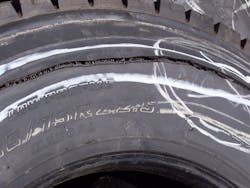Are you paying proper respect to pressure?
It’s no secret that proper inflation pressure is the key to truck tire life and performance. When tires are overinflated, any gains in decreased rolling resistance are offset by accelerated tread wear.
On the other hand, when tires are underinflated, the increased rolling resistance causes poor fuel mileage, while the additional heat increases the likelihood of a belt separation. Insufficient inflation pressure for the load also leads to irregular tread wear.
Consequently, one would think proper tire inflation would be a top priority for every maintenance operation. After all, the evidence clearly shows that when the correct air pressure for the load is consistently being used inside the tire, tread wear is usually slow and even.
Unfortunately, inflation pressure is the Rodney Dangerfield of the truck tire business because it doesn’t get any respect. From the technicians who don’t use restraining devices to the drivers who rely on a thumper to check for flats, the lack of attention is destined to cause an accident and/or lead to increased operating costs.
Yet, the disrespect continues each day, so technicians are injured and fleets spend more on tires than they should.
Evolving Risks
Back in the days of multi-piece rims, most technicians were rightfully scared to death of being hurt or killed by a component separation. Even the most inexperienced tech would instantly realize that a lock ring could fly off and become incredibly dangerous when the tire pressurized.
Then, the single-piece rim came along and suddenly the risk appeared to be gone. So, restraining devices, or safety cages, were used for everything except inflating tires.
By the time tubeless steel radial tires started taking over the trucking market, a new risk to technicians was uncovered. Since the sidewalls on radial tires are designed to flex when loaded, excessive flexing caused fatigue in the steel sidewall cables.
If the excessive flexing continued for an extended period of time, the individual wires within each cable would start to break around the circumference of the tire.
During the inflation process, the fatigued cables would snap one-by-one and produce a popping sound with a bulge on the sidewall. If the inflation was allowed to continue, a series of cables would break simultaneously and release a sudden burst of air.
The damage to the tire after the explosion resembled the zipper on a jacket, so the zipper rupture was born.
Lessons Learned
Unfortunately, experience still led to overconfidence in too many situations, so the injuries related to inflating truck tires continued. A technician with 20 years on the job would think that there’s no shrapnel, so what harm could come from a little air?
Some of them learned the hard way by being thrown against a wall or a trailer. Others suffered the internal injuries that accompany the blunt force trauma that occurs when 80 psi launches the tire and wheel into the chest or head.
Eventually, most people got the message and started using restraining devices again, although there are still isolated incidents of someone being injured because a zipper rupture occurred outside the device.
Heat Damage
Another condition that can cause a serious accident when inflating tires is heat damage to an aluminum disc wheel.
There are a number of ways excessive heat can reach the point where the integrity of the metal is compromised, but the end result is a rim that becomes incapable of supporting the bead opposite the disc when pressurized. In some instances, the heat will actually discolor the aluminum and give it a bronze appearance opposite the disc.
These wheels can be identified by rolling them on a straight floor - a damaged wheel will curve - or by checking them with a carpenter’s square - disc face to opposite rim flange should not produce a gap opposite the disc.
Unlike zipper ruptures that are typically preceded by the popping sound, separations from heat damage to the wheel occur without warning and turn the escaping air and the assembly into a dangerous projectile.
OSHA Compliance
Of course, none of this matters if technicians use an OSHA-compliant tire inflation system.
Federal law requires that three components must be in place for every tire inflation system must. There must be a clip-on air chuck so the technician doesn’t have to stand next to the valve stem.
There must also be a sufficient length of hose so the employee can stand outside the trajectory of both sidewalls.
Additionally, tire inflation systems must have an in-line valve with a pressure gauge or a presetable regulator, both of which prevent accidental overinflation.
It doesn’t matter who is doing the tire inflating or the location of the inflation. When a truck tire is being inflated, the three aforementioned components must be in place.
Technically, the restraining device is only required for multi-piece assemblies, as OSHA allows tires on single-piece rims to be inflated on the vehicle if the lug nuts are fully tightened. But, every tire manufacturer and industry organization, including TIA, recommends using a restraining device when inflating any type of truck tire.
You rarely hear about inflation-related accidents when the assembly was in the restraining device. Yet most of the horror stories start with a safety cage still in the bed of the truck or in a corner of the shop.
If your fleet is inflating truck tires in any way, there are OSHA regulations and other industry recommended practices that apply.
Compliance Training
TIA’s Fleet Tire Service OSHA Compliance Training Program outlines all of the federal requirements for an inflation system and includes the step-by-step inflation and inspection procedures to identify zipper ruptures or disc wheels damaged by heat.
The program’s video also demonstrates the consequences of standing inside the trajectory of the sidewall should a zipper rupture occur.
For more information on how this training program can help you protect your employees from an accident with a pressurized tire, contact TIA’s director of training Chris Marnett at 800-876-8372, ext. 106, or [email protected].
